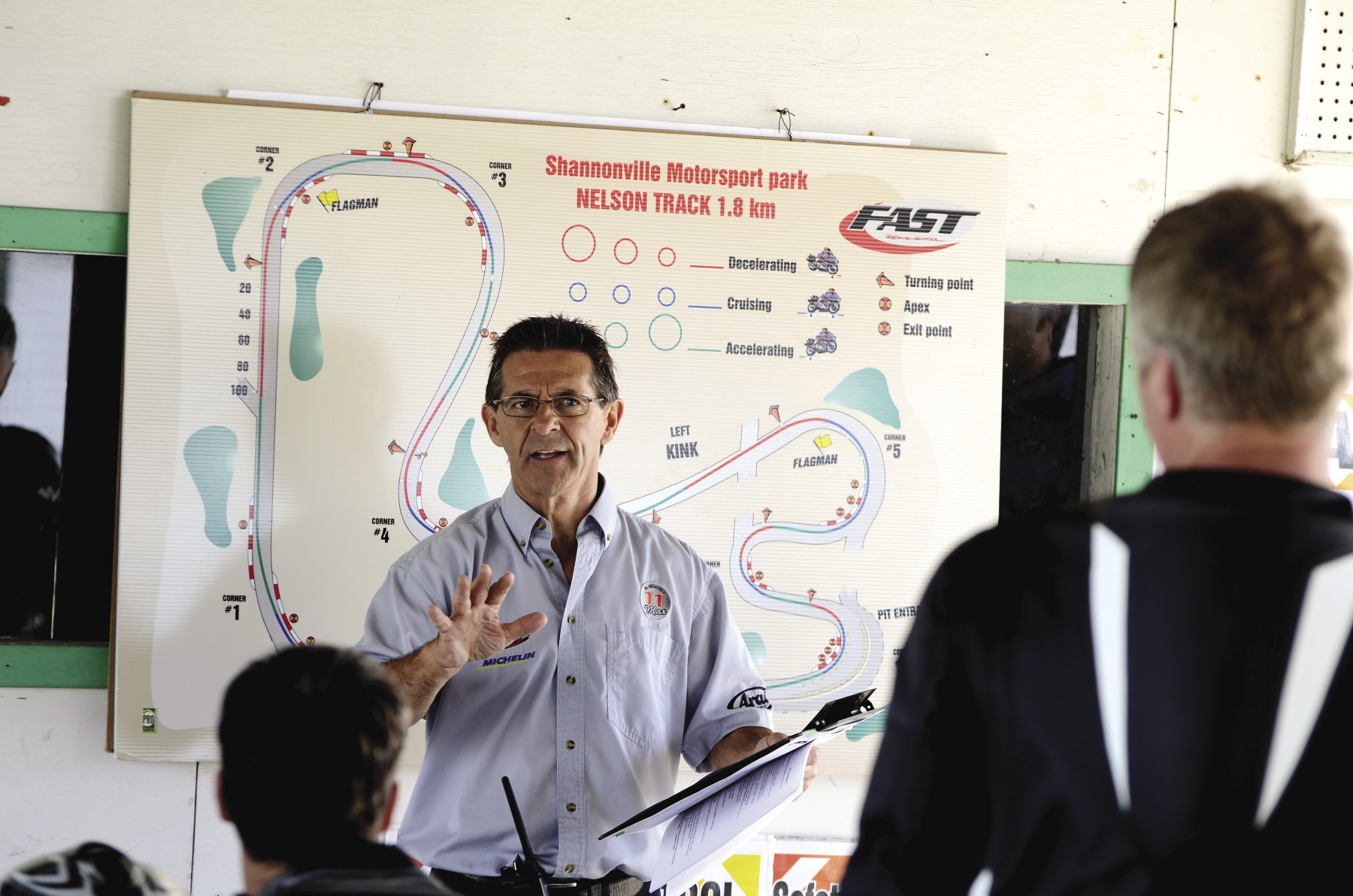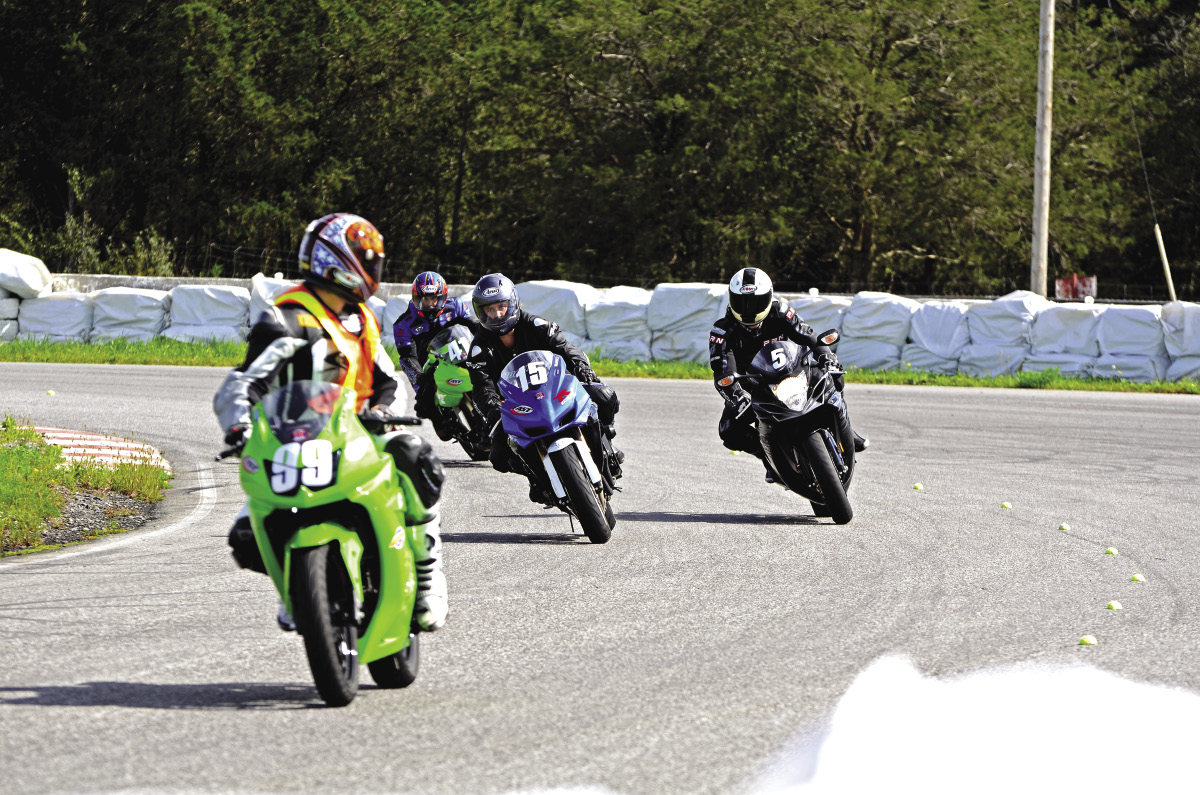
Location: Shannonville Motorsport Park, Shannonville, ON
Price Range: Own motorcycle & gear, $359; Everything supplied (motorcycle & riding gear), $559
Website: www.fastridingschool.com
We don’t talk about defensive riding here,” Head Instructor Michel Mercier warns the students of his Phase 1, FAST Riding School class. Not one to pull any punches, he surveys the faces in front of him and addresses what is clearly on the minds of the many first timers. “We have an ambulance,” he says with a mischievous grin, “but don’t worry about that. We all know that crashing is something that only happens to the other guy.”
Something that Mercier hasn’t said yet, and every experienced track rider already knows, is that a race track is the safest environment in which to learn how to ride fast. And Mercier, a member of the Canadian Motorcycle Hall of Fame, has the experience to prove it. In operation since 1987, his FAST Riding School has trained over 17,000 students and is the oldest motorcycle school of its kind in Canada. Then there’s Mercier’s impressive 18-year racing career, during which he won 25 Canadian national championships in a variety of disciplines such as motocross, dirt track, ice racing and road racing. If there’s anyone qualified to bring a rider up to speed, it’s Michel Mercier.
The FAST Riding School at Shannonville Motorsport Park, just east of Belleville, Ontario, offers three levels, or Phases, of on-track instruction that run between May and September. Each Phase consists of a one day course with Phases 2 and 3 building upon the lessons learned in the previous level. Students have the option of an all-inclusive package ($559) that provides full-coverage racing gear and a late-model sport bike, or they can save a little money by using their own motorcycle ($359). In each class students are broken into three groups – conservative, intermediate, and more experienced. Although you don’t require a motorcycle license to participate, FAST assumes that their students have already mastered the basic skills required to operate a motorcycle. It’s not a learn how to ride school – it’s about learning how to ride fast.
I’ve been invited to participate in the Phase One class, which uses the 1.7 km Nelson track configuration that offers a good variety of turns over various surface conditions. The course starts with a one hour classroom session conducted by Mercier, who is quick to point out that everything learned on the track can be applied to every genre of street riding. Looking around, I notice that there are riders from every walk of life in attendance. There are the predictable young guns, a smattering of grey-haired retirees, and a few women too. It’s unlikely that anyone from my class will be joining FAST’s list of distinguished alumni, which includes the likes of Kevin Lacombe, Pascal Picotte, and Frank Trombino.
Mercier’s experience as an instructor is immediately obvious. Despite being able to recite the course’s material in his sleep, Mercier instructs in an assertive and engaging manner. His keen sense of humour makes the otherwise dry information entertaining and his animated movements keep the students, who are starting to daydream about being on a bike, focused on what he’s saying.
“Race tracks are about turns. Anyone can go fast in a straight line,” Mercier says, emphasising the goal of Phase One is work on the five elements that will gradually increase a rider’s speed. He covers the proper use of your eyes to balance the perception of speed, discusses the types of ways in which a motorcycle can be steered, explains the physics behind traction, analyses the use and timing of braking, and emphasises the importance of taking advantage of the room available on a race track.
Mercier warns everyone that they should always stay within their comfort zone, and above all else, “always look to where you want to go.” These are two of many key points that are repeated throughout the day in the hope that they will penetrate even the thickest of skulls. Riding fast, on a track, requires absolute concentration, all of the time. Riding at the speeds modern sport bikes are capable of requires a brain to process a myriad of data very quickly, much of it sub-consciously. Part of the FAST School’s process is to vocalise and explain the things that riders do instinctively, and how an understanding of the underlying physics involved in riding can make you a faster rider.
At the commencement of the class session, everyone moves outside and spends the balance of the day in 30 minute rotations that consist of a 10 minute track session, a debriefing of the session by each group’s on-track riding instructor, and a new, short tutorial from Mercier. The first sessions are reserved for breaking down a few of the basics required by a fast and smooth rider. The various on-bike lessons include throttle steering, braking and how to effectively down-gear and prepare for a turn. Nothing seems to escape Mercier’s attention. In the middle of a sentence during one of our intersession lectures, he suddenly grabs his radio and is in communication with a corner marshal, asking for the plate number of the motorcycle that is heading toward turn two. From our track-side classroom, he could tell by sound alone that a passing rider was riding too aggressively and wanted to know who it was.
After a very full and satisfying day, we retire back to the main classroom for a brief recap, a small award ceremony, and the distribution of our FAST Riding School graduation certificates. The FAST certificates are recognised by various regional racing organisations such as RACE, and they allow a rider to obtain a road racing licence. However, you don’t have to be a budding racer to benefit from a day spent at the school. I can’t think of a single motorcyclist, regardless of their riding interest, who wouldn’t leave Shannonville a better overall rider after attending the FAST Riding School. As everyone heads for the parking lot, a few students who also happen to be knowledgeable racing fans hang around and get autographs from the head instructor. After all, it’s not often that you get a chance to improve your skills with the help of a Canadian legend.

























